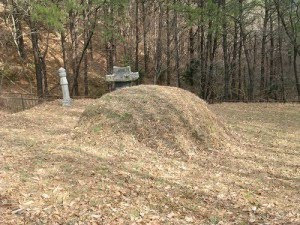My Chuseok consisted of a trip with Yumi to her hometown of Yeongju (영주). We spent the weekend prior to Chuseok with her parents, where I was honored to take part in her family's celebrations. Her father invited me along with the other males in the family to clean up the grave sites of their parents. We spent a few hours in the rain clearing brush, cutting grass, and performing traditional Buddhist prayers at the hills. A note on Korean grave sites: Unlike America, Koreans bury their dead "sitting upright", so their grave sites look like mounds of grass and dirt. They also bury their dead on mountainsides, and the higher up, the more respect the person was given.
 |
| Traditional Korean burial mound |
I also recently got to travel out to a small island called Baekryeong-Do (백령도), which if you Google or Wiki, you will see is frighteningly close to North Korea. It also happens to be the site of the March 26th North Korean sinking of the ROK frigate Cheonan, where 46 sailors lost their lives. The island was absolutely beautiful...for the first day. I spent five days on the island, but only saw two days of sun with decent temperatures. The rest of the time, it was either raining or too cold for the shorts I packed. When we landed on Monday, it was in the 70's and nice. On Wednesday, it dipped all the way down to the low 50's, which wouldn't be bad had I brought some long pants.
 |
| Map of Korea: Baekryeong-do highlighted in red |
The island was a lot larger than what I previously thought. The port was tiny, but the city was fairly big. The island is called home by about 4,000 people, and contains pretty much all the amenities that they need. The have restaurants ranging from traditional Korean to pizza and chicken joints. They have multiple bars, mini-marts, and bakeries to keep you busy with food. The island rarely sees outsiders, but surprisingly, most of the shop signs had English translations on them. We speculated this was due to the Cheonan investigation teams staying on the island a few months back.
One thing that was notable about my trip was something I saw on Thursday out in the sea. There was a fleet of military vessels, about 12, that were patrolling the northern part of the island in the ocean. Our translator told us that the boats were Chinese, which is kind of spooky to me.

>Koreans bury their dead "sitting upright"
ReplyDeleteI don't think Koreans have done that since the Neolithic times. The mound is just a symbolic decoration, you know. Below it you'd find the usual wooden coffin lying horizontally. ;-)
Learn something new every day. Thanks!
ReplyDelete